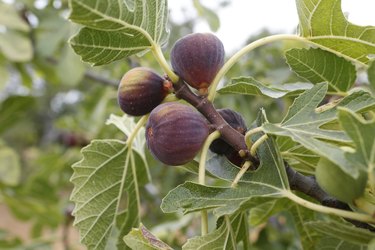
The name "fig" is used to describe trees, shrubs and vines in the fig family. The fruit-producing fig tree is native to tropical and warm temperate regions. The fig tree is a small, hearty tree with heights ranging from 10 to 30 feet. However, maintenance issues, pests and soil deficiencies can cause yellowing of fig tree leaves, given the right conditions.
Fig Tree Facts
Video of the Day
The fig tree, Ficus carica, ranges in height from 10 to 30 feet with a trunk diameter of around 7 inches, according to Purdue University. The tree produces a small pear-shaped fruit that ranges from 1 to 4 inches long, and comes in a variety of colors from yellowish-green to dark-purple. According to the University of Minnesota (UMN), fig trees grow best with temperatures exceeding 50 degrees F. Adaption to a new environment and cool temperatures are a common cause of yellowing fig tree leaves.
Video of the Day
Adapting to a New Environment
Ficus trees can lose up to 20 percent of their foliage when adapting to a new environment. Varying temperatures, even minute changes, can cause yellowing and eventual death of fig tree foliage. Cool nighttime temperatures below 50 degrees F can cause loss of foliage and yellowing of leaves. However, because the fig tree is deciduous, it is normal for yellowing of leaves and loss of foliage during the cool months of the fall season.
Overwatering or Underwatering
Underwatering and overwatering of the fig tree can cause wilting and yellowing of leaves. According to the Texas Agricultural Extension Service, the roots on fig trees are close to the soil surface and can easily dry out. Regular watering in well-drained soil promotes healthy green foliage, whereas a water deficiency will turn leaves pale yellow.
Nitrogen Deficiency in the Soil
Nitrogen is one of the primary nutrients found in all soil and soil fertilizer. It helps promote cell division and leafy green growth during the spring when foliage first appears. According to the Soil Science Education website operated by NASA, soil with a nitrogen deficiency causes plant leaves to turn yellowish-green. University-based or private labs can test nitrogen levels in soil to determine the proper application of fertilizer during the growing season. If a nitrogen deficiency is detected, a nitrogen-based fertilizer can remedy the situation.
Problematic Insect Infestations
Insect infestations are a common cause of yellowing leaves on most fig tree varieties. According to the UMN, insects such as scale, mealy bug and spider mites are the most common to infest the fig tree. Although insect infestation is rare in healthy fig trees, insecticides and insecticidal soap sprays are the most common solutions.